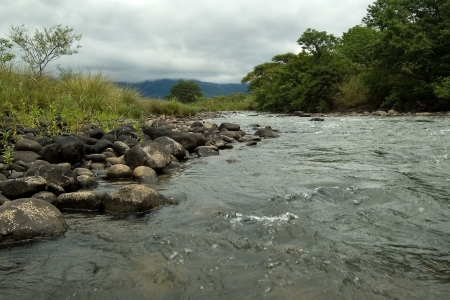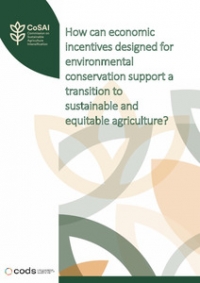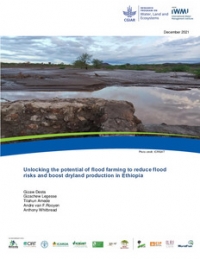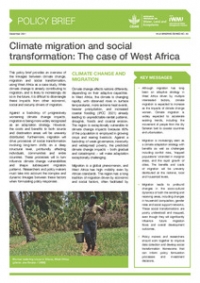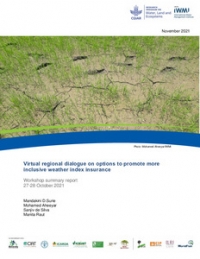This post is part of the Agriculture and Ecosystems Blog’s month-long series on Resilience.
“Resilience” resounds throughout most discourses on agricultural development and is abundantly referenced through most projects related to adaptation to climate change and agriculture. However, when pressed to describe resilience, experts will give you a plethora of different definitions and a number of useful principles.
 Working with a group of farmers in the Segou region of Mali. Photo: John Choptiany
Working with a group of farmers in the Segou region of Mali. Photo: John ChoptianyThere are still very few tools to assess the resilience of farmers, from the perspective of the farmers themselves. Over the past year, a group within FAO in collaboration with external partners have been developing a tool, the Self-evaluation and Holistic Assessment of climate Resilience of farmers and Pastoralists (SHARP) to enable smallholder farmers and pastoralists to assess their own resilience while providing important data for scientists and policy makers’ efforts in climate adaptation.
Developing and field testing a resilience self-assessment tool
SHARP was developed following a thorough review of resilience theory and existing sustainability and climate resilience tools working together with a team at the University of Leeds (see Dixon et al., 2014). Resilience measurement is built upon the work by Cabell and Oelofse (2012) to determine a set of agro-ecological resilience indicators that have relevance for individual farmers or pastoralists.
Using these indicators, we developed a self-assessment survey for farmers and pastoralists. Each question in SHARP is linked to individual resilience indicators, which can be used as a proxy for the level of resilience of farmers and pastoralists to climate change. SHARP involves three major phases:
- A participatory self-assessment survey of smallholder farmers and pastoralists regarding their climate resilience;
- A gap analysis and assessment of the responses at both the local level with the farmers and pastoralists in a rapid assessment and through a cross-sectional review of multiple assessments, which includes engagement with local government officials and policy makers to assess agricultural and pastoral policies regarding effectiveness and gaps; and
- Use of this information in conjunction with climate and scientific data to inform and guide farmers’ practices as well as curricula and local and national policies.
Based on the theoretical grounding four weeks of testing SHARP in both West and East Africa took place. We met with over 350 farmers and pastoralists and tested the survey using different methods (focus groups, individual, gender segregated etc.) In areas of low literacy, SHARP was facilitated by agro-pastoral/farmer field school (AP/FFS) facilitators or extension workers. The work in the field level helped us to improve the formulation of questions and adapt them to better link to resilience indicators with practicalities on the ground.
Implementing the SHARP tool
The self-assessment leads the interviewee to consider their environmental, social, economic, governance and general practices, to obtain a holistic understanding of agricultural resilience. The farmers and pastoralists answer questions tailored to their specific context and also assess the adequacy of the component (e.g. access to markets or water quality) and then indicate the importance of that component to their livelihood. Facilitators discuss the survey with the farmers and pastoralists and the results generate a dialogue and shared learning opportunities among the community.
The responses from the self-assessment are pooled into a rapid assessment (Phase 2), which produces a priority ranking of resilience indicators. The ranking is based on the farmers’ self-assessment of how satisfied she or he is with the current state and how important the issue (e.g. water quality, access to credit) is to them. For example, a farmer may indicate that water quality is very poor but very important whereas invasive species are not a concern and do not impact their livelihood.
Through field-testing in Uganda, Mali and Senegal, we reached family farmers who have experienced extreme droughts, floods, cattle raiding and crop failure due to pests. Our rapid assessment of the responses from farmers in Mali identify animal nutrition, record keeping, financial support and locally adapted plants as key areas of low resilience but high importance.
We found that smallholder farmers and pastoralists were eager to share and discuss their experiences. The survey appeared to be an opportunity for field school members to exchange ideas on how to adapt or improve their practices. The process empowered farmers and pastoralists to identify and prioritize areas needing improvement and to take ownership of these issues to work with other community members and actors towards improved climate change resilience.
When SHARP is implemented, the data from the rapid assessment will be fed back to the farmers, pastoralists, and the agro-pastoral and farmer field school staff to adapt field school curricula to each unique situation. This is one of the major benefits of SHARP; we integrate the tool with participatory and community-driven programmes, such as farmer field schools (which are increasingly recognized as a best practice for building farmer capacities) to ensure that locally crafted strategies will be created to increase productivity and resilience.
After the first two phases and at a macro scale, the data can be used to highlight strengths and weaknesses of programmes (e.g. FFS) in different countries to improve smallholders’resilience. This information can then be combined with climate models where available and be used by policy makers to develop effective policies and programmes.
Way Forward
SHARP offers a participatory instrument for farmers and pastoralists to self-assess their climate-resilience which, as the feedback from the field level shows, can be relevant and useful for farmers, development practitioners, and researchers.
We plan to implement SHARP in 12 upcoming climate change adaptation projects in sub-Saharan Africa to help family farmers assess their climate change resilience and provide the necessary first steps towards improving it.
Join the e-discussion
We will be holding an e-discussion forum in June and are looking for participants to help in providing comments on the scoring system used within SHARP in order to further calibrate the tool. If you are interested in contributing, please get in touch with John Choptiany at john.choptiany@fao.org.
For more information:
The SHARP tool.
Agricultural Plant Production and Protection Division (AGPM) of FAO
Cabell, J.F. & Oelofse, M. 2012. An Indicator Framework for Assessing Agroecosystem Resilience. Ecology and Society. 17(1): 18.
Dixon, J.L., Stringer, L.C. & Challinor, A.J. 2014. Farming system evolution and adaptive capacity: insights for adaptation support. Resources. 3(1): 182-214.
The development of SHARP has received funding from the European Union through the “Improved Global Governance for Hunger Reduction Programme." The views expressed herein can in no way be taken to reflect the official opinion of the European Union or the Food and Agriculture Organization of the United Nations.






